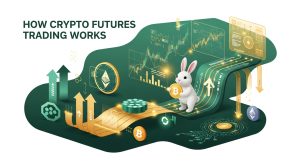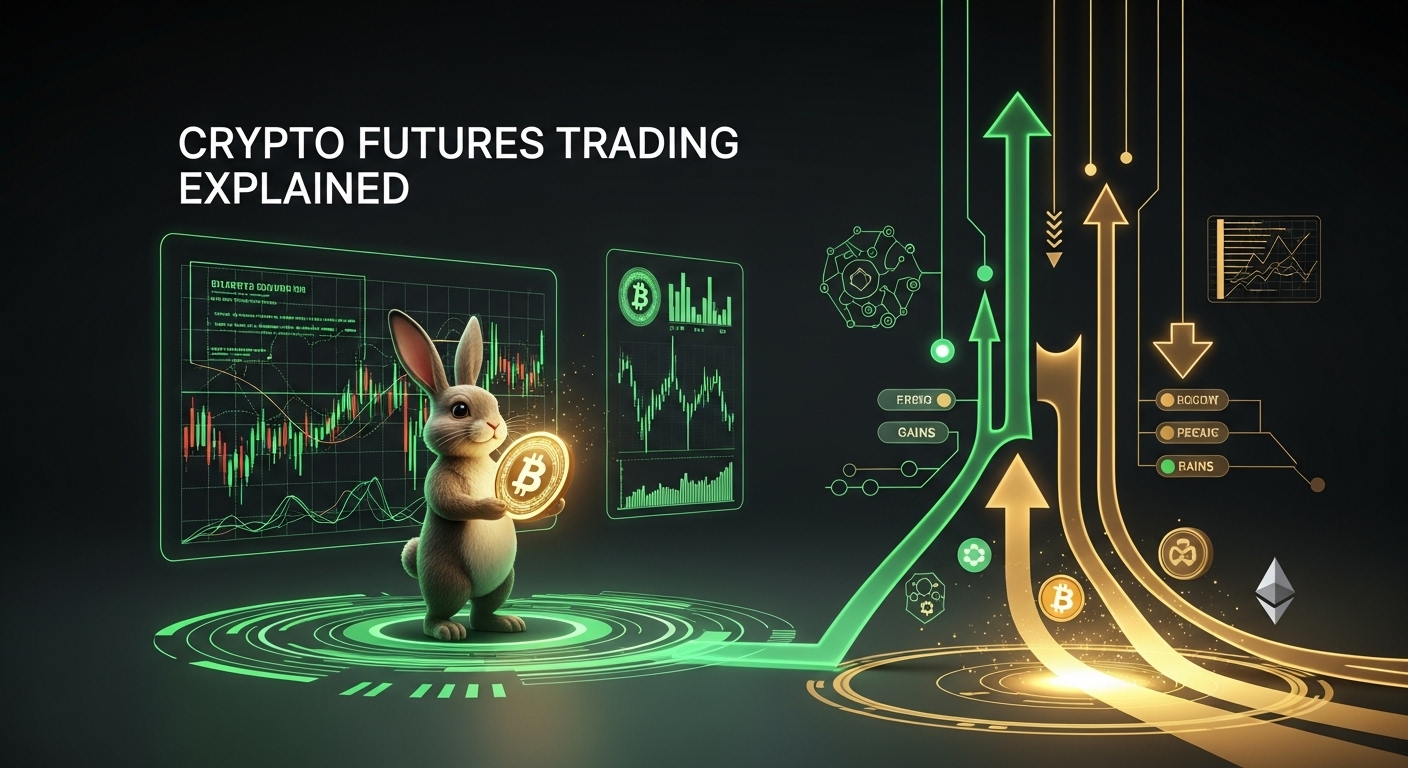Crypto futures are contracts that let traders buy or sell a cryptocurrency at a set price on a future date. This tool matters because it allows traders to speculate on price movements without owning the actual coins, opening opportunities to profit in both rising and falling markets.
This guide will walk you through the basics of crypto futures, how they work, the risks involved, and tips for choosing the right platform. You’ll also find strategies suited for beginners to help you get started confidently. If you’re looking to understand crypto futures and make informed trades, this is the place to start.
For a deeper understanding of related trading methods, check out our introduction to CFD trading and the insights on CFD brokers for crypto trading explained.
What Are Crypto Futures?

Crypto futures are contracts that let you agree today on buying or selling a cryptocurrency at a specific price on a future date.
Think of them like pre-booking a plane ticket. You lock in the price now before you actually travel. With futures, you don’t need to own the crypto upfront; instead, you’re betting on where the price will go.
This opens opportunities to profit from both upward and downward price moves in the market.
Understanding the basics of these contracts and the different kinds available will help you trade more confidently. Let’s break down the key terms and types of crypto futures you’ll encounter.
Contract Basics
Imagine a crypto futures contract as a promise sealed with clear details. Three essentials define this promise:
• Contract Size: This is like the size of a pizza you’re ordering. It tells you how much of the cryptocurrency each contract represents. For example, one contract might equal 1 Bitcoin, or a fraction of it. Knowing the size helps you understand your potential profit or loss.
• Expiry Date: Think of this as the “use-by” date on a milk carton. It’s when the contract ends, and you must settle the deal. Expiry dates can be weekly, monthly, or quarterly, depending on the contract type.
Settlement Type: This is how the deal concludes. Settlement can be:
• Cash Settlement: You don’t exchange the actual coin but instead settle the profit or loss in cash. Imagine settling a bet by paying or receiving money rather than swapping items.
• Physical Settlement: Here, the actual cryptocurrency changes hands when the contract expires.
Each of these parts shapes how you plan your trades, from sizing your position to knowing when to close it.
Types of Crypto Futures
Different futures contracts come with unique features, affecting your margin, funding costs, and strategy.
• Perpetual Contracts: These are the pizza that never expires. Perpetual futures have no expiry date, so you can hold your position indefinitely.
They use a small periodic fee called the funding rate, paid between buyers and sellers to keep the contract price close to the spot market price. This funding can either add to your cost or boost your profits depending on the market trend.
• Quarterly Contracts: Like a seasonal pizza special, these contracts have a fixed expiry date every three months. You must settle your position on that day, either in cash or the underlying asset. These contracts usually have lower funding fees but require more attention to expiry to avoid unexpected settlements.
• Inverse Futures: These contracts work a bit differently, they’re often quoted in USD but settled in the cryptocurrency itself.
Imagine ordering a pizza but paying in slices of another type of pizza. Because settlement is in crypto, margin requirements and price movements feel different, especially when Bitcoin fluctuates widely.
These futures can expose you to unique risks and rewards compared to standard contracts.
When you understand these types, you’ll see how margin requirements and funding fees vary, which can impact your trading cost and potential profit.
If you want to explore how contracts in trading compare to other financial products, our guide on CFD vs stock trading: crypto futures perspective offers clear insights to expand your knowledge.
How Crypto Futures Trading Works

Trading crypto futures can feel like managing a finely tuned machine. You need to understand the key parts in motion: margin, leverage, and how to place and manage your trades.
These elements together define your potential gains or losses, as well as how much risk you carry. Let’s break this process down so you see exactly how it works in practice.
Margin and Leverage
Margin is the amount of money you need to put up as collateral to open a futures position. Think of it as a security deposit for your trade. It’s not the full value of the crypto contract but a fraction of it, so you don’t have to pay the entire price upfront.
Leverage allows you to control a larger position than your margin. It’s a multiplier that increases your exposure relative to what you actually invest. For example, if your leverage is 10x, you can open a position ten times bigger than your margin.
Here’s a simple breakdown:
• Suppose you want to trade 1 Bitcoin futures contract priced at $30,000.
• The exchange requires a 10% margin.
• Your margin (collateral) will be $3,000.
• With 10x leverage, your exposure is $30,000, even though you only put down $3,000.
This setup gives you a chance to earn more profits from price moves. But remember, higher leverage also means higher risk. If the price moves against you, losses multiply as well.
Placing and Managing Orders
Starting a crypto futures trade involves a few clear steps that anyone can follow.
• Choose your contract: Decide if it’s a perpetual or fixed-expiry futures contract.
• Set position size: Based on your margin and leverage, pick how many contracts or how much of the crypto you want exposure to.
• Enter your order: You can buy (go long) if you expect prices to rise or sell (go short) if you expect them to fall.
• Add risk controls: Before confirming, set stop-loss orders to limit losses and take-profit orders to lock in gains automatically.
• Monitor your position: Futures trading is active, so adjust your position size or protective orders as the market moves.
For example, if you open a long position on Bitcoin futures at $30,000, you might want to set a stop-loss at $28,000 to control risk and a take-profit at $35,000 to secure potential earnings.
Using stop-loss and take-profit orders effectively allows you to trade with more control and discipline, helping to avoid emotional decisions.
Getting familiar with these steps will make futures trading feel like a routine rather than a gamble. The goal is to take calculated positions, use your margin smartly, and manage your trades actively.
For more detailed tips on safely handling your trades, exploring the best crypto exchanges for buying Bitcoin could also help you find platforms that offer solid futures trading features.
Key Risks and Risk Management

When trading crypto futures, understanding the main risks and how to manage them is essential. The market’s volatility, combined with leverage, can quickly turn your profits into losses if you’re not careful.
Let’s focus on two critical risk areas: liquidation risks and funding fees. Knowing these will help you protect your capital and trade smarter.
Liquidation Risks
In crypto futures trading, your position relies heavily on margin, the collateral you put up to open and maintain a trade.
Every contract requires you to maintain a minimum margin level, called the maintenance margin. If your account’s margin balance falls below this level, your position is at risk of being liquidated.
Think of liquidation as a forced sale of your position, executed to cover losses and prevent your account from going negative. Liquidation typically happens when the market moves sharply against your position or if you use high leverage without proper margin monitoring.
Here’s what you should keep in mind:
• Margin Ratio Monitoring: Keep a close eye on your margin ratio, which compares your current margin to the maintenance margin. As the price fluctuates, this ratio shifts, and falling too low puts you in liquidation territory.
• Regularly Check Mark Price: Many exchanges use a “mark price” to calculate margin calls and liquidations, which can differ from the spot price to reduce unnecessary liquidations during volatile swings.
• Use Stop-Loss Orders: Setting stop-loss limits helps exit positions automatically before liquidation risk becomes serious.
• Manage Leverage Wisely: Higher leverage means smaller price moves can wipe out your margin, so be cautious with how much leverage you take.
Being proactive with these steps prevents unexpected liquidation and preserves your trading capital.
Funding Fees Explained
Another crucial aspect to understand is funding fees. For perpetual futures, unlike fixed expiry contracts, exchanges use funding payments to keep the futures price closely aligned with the spot market price.
These payments occur periodically, usually every 8 hours, and they transfer money between traders holding long and short positions.
Here’s how it works:
• When the futures price trades above the spot price, traders with long positions pay those with short positions.
• When the futures price trades below the spot price, short positions pay the longs.
• Funding rates can be positive or negative, and they fluctuate with market sentiment and volatility.
Before you open a trade, check the funding fee schedule for your chosen contract. Sometimes, funding fees can significantly impact profitability, especially if you hold a position for a long time or use high leverage.
A few tips on handling funding fees:
• Consider Timing: Holding a position through funding intervals can add costs or gains depending on the rate direction.
• Plan for Expenses: Include funding fees in your break-even calculations.
• Choose the Right Contract: Fixed expiry futures don’t have funding fees, which may suit certain strategies better.
Understanding both liquidation risks and funding fees arms you with the knowledge to maintain better control over your trades and avoid avoidable losses.
For more on margin and risk management strategies, exploring general concepts in margin trading basics can provide additional practical insights.
Choosing a Platform and Broker
When it comes to trading crypto futures, picking the right platform and broker shapes your entire experience. The platform’s features, fee structure, ease of use, and the broker’s reliability can influence how well you trade.
Some traders prefer direct crypto futures exchanges, while others opt for CFD brokers that simplify futures access without the hassle of actually owning the coins.
Focus on a broker or platform that matches your trading style and fits your level of experience. Look closely at cost transparency, available tools, and customer support quality.
The right choice can reduce headaches and boost your confidence when trading.
CFD Brokers for Crypto Futures
CFD brokers offer a unique way to trade crypto futures without needing to hold the underlying cryptocurrency.
Instead, you trade contracts that track the price changes, which means you’re never owning the actual asset. This setup can make trading simpler and faster, with less worry about wallets or coin transfers.
One major advantage is the ability to use margin and short sell easily, making it flexible for multiple strategies. However, always check the broker’s fee structure and trading conditions to avoid surprises with commissions and spreads.
If you want to understand more about how these brokers work and what they bring to the table, see our detailed look at What CFD brokers offer for crypto futures. It breaks down their benefits and what to watch out for.
Spotlight: TradeEU Global
TradeEU Global has gained attention among futures traders for its straightforward and transparent approach. The platform focuses on giving clear pricing and robust tools without overcomplicating the user interface. Its fee structure is competitive, with low commissions and tight spreads that help keep trading costs manageable.
The user interface is clean and easy to navigate, which suits both beginners and experienced traders. You’ll find quick access to charts, order types, and risk management features that support confident trading decisions.
Plus, TradeEU Global’s customer service is responsive, providing an extra layer of support when needed.
For a deeper look at what this broker offers and how it stacks up in the futures market, check out our TradeEU Global review: crypto futures trading insights. It covers everything from platform usability to fees and extra features useful for futures traders.
Beginner Strategies for Crypto Futures
Starting with crypto futures can feel overwhelming, but the right strategies help ease the learning curve and improve your chances of success.
Two simple yet effective approaches to consider are spreading your entries over time to lower risk and using futures contracts to protect your existing crypto holdings.
These strategies balance growth and risk control, which is crucial when diving into volatile markets. Let’s look at each in more detail.
Dollar‑Cost Averaging with Futures
Dollar-cost averaging (DCA) is a well-known method used in regular crypto buying, and it fits futures trading just as well.
Instead of entering a futures position all at once, you divide your total investment into smaller chunks and open multiple positions over a set period.
This approach softens the impact of sudden price swings and reduces the risk of buying at a market peak.
Here’s how it works:
• Break your total desired exposure into equal portions.
• Enter a futures position with one portion at regular intervals, daily, weekly, or based on market conditions.
• This staggered entry lowers the chance of a big loss if prices drop immediately after your first trade.
For example, if you want exposure to Bitcoin futures worth $10,000, instead of buying all at once, you might open five $2,000 positions over five weeks.
If the price dips, your later entries capture lower prices, averaging your overall cost down. This strategy builds steadier positions and avoids the common trap of timing the market perfectly.
Dollar-cost averaging with futures works best in markets where you expect price growth over time but want to limit exposure to short-term swings.
It also gives you flexibility to adjust subsequent orders based on how the market moves.
Hedging Spot Holdings
Another powerful strategy for beginners is using futures contracts to hedge your existing cryptocurrency investment. Suppose you own Bitcoin or Ethereum in your spot wallet and worry the market might drop. Shorting futures provides a buffer against losses without selling your actual coins.
Here’s the basic idea:
• You hold a spot long position (own the crypto).
• Open a short position in futures for an equal or slightly smaller amount.
• If prices fall, losses on your spot holdings are offset by gains from the futures short.
This setup acts like insurance. It lets you keep your crypto for the long term while protecting your portfolio from short-term dips.
The hedge isn’t perfect; funding fees or timing mismatches can slightly affect overall results, but it significantly lowers risk in volatile markets.
Hedging works well during uncertain times or when you expect a market correction but don’t want to exit your crypto investments permanently. Just remember to monitor your futures positions regularly to adjust them as the market moves.
Both these beginner strategies, dollar-cost averaging with futures and hedging spot holdings, offer practical ways to start futures trading with a focus on risk management. Use them to build confidence while exploring more advanced futures tactics down the line.
Conclusion
Crypto futures trading offers opportunities for profit and risk management by allowing traders to speculate on price movements without owning the underlying coins. Understanding key concepts like contract types, margin, leverage, liquidation risks, and funding fees is essential for navigating this market confidently.
Education and careful risk control make all the difference. Applying beginner strategies such as dollar-cost averaging or hedging can help you build experience while managing exposure.
For more detailed guidance, explore related topics like Crypto Arbitrage Trading Explained (Opportunities and Risks) and How to Mine Cryptocurrency (A Clear Guide for Beginners). Staying informed connects your trading decisions to a broader understanding and supports smarter outcomes over time.

Adeyemi Adetilewa is a digital marketing strategist and writer with over a decade of experience helping B2B, SaaS, Web3, and eCommerce brands grow through data-driven marketing. Adeyemi empowers professionals and business owners with actionable insights, growth strategies, and digital tools for success.

